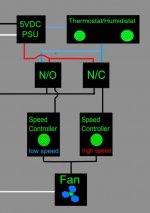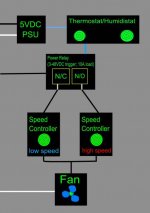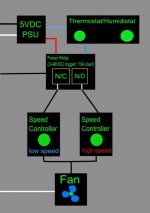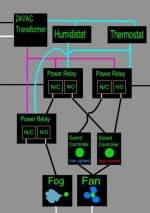moonquasar
Member
I'm interested in wiring my fan for two speeds - a low speed for when both temperature and humidity are below their respective set points and a high speed for when they are above their set points.
Here's a diagram to illustrate what I'm thinking. I know this has been done before in one form or another. I'm looking for a simple effective economical solution. Your feedback is appreciated.

The current diagram shows using a 5VDC PSU and 5VDC -> 120VAC relays. This could also be set up using no PSU at all and 120 -> 120VAC relays.
I was thinking of using two triacs to set the high and low speeds. Perhaps it would be just as good to set the low speed and have the high speed always at full.
Thoughts?
Here's a diagram to illustrate what I'm thinking. I know this has been done before in one form or another. I'm looking for a simple effective economical solution. Your feedback is appreciated.
The current diagram shows using a 5VDC PSU and 5VDC -> 120VAC relays. This could also be set up using no PSU at all and 120 -> 120VAC relays.
I was thinking of using two triacs to set the high and low speeds. Perhaps it would be just as good to set the low speed and have the high speed always at full.
Thoughts?







